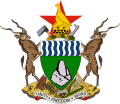| No. | Name | Tenure | Title |
|---|
| Southern Rhodesia (1923–1954) |
|---|
| 1 | Robert James Hudson | 1 October 1923 – 5 July 1933 | Minister of Defence |
|---|
| 5 July 1933 – 12 September 1933 | Minister of Justice and Defence |
| 2 | Stephen Martin Lanigan O'Keeffe | 12 September 1933 – 14 November 1934 | Minister of Defence |
|---|
| 3 | Vernon Arthur Lewis | 14 November 1934 – 6 October 1936 | Minister of Justice and Defence |
|---|
| 4 | Robert Clarkson Tredgold | 6 October 1936 – 12 January 1940 | Minister of Defence |
|---|
| 12 January 1940 – 28 March 1940 | Minister of Justice, Defence and Air |
| 28 March 1940 – 1 March 1943 | Minister of Justice and Defence |
| 5 | Sir Godfrey Huggins | 1 March 1943 – 2 February 1944 | Minister of Defence |
|---|
| 6 | Frank Ernest Harris | 2 February 1944 – 1 July 1945 |
|---|
| 7 | William Henry Ralston | 1 July 1945 – 7 June 1946 |
|---|
| 8 | Sir Ernest Lucas Guest | 7 June 1946 – 15 September 1948 | Minister of Defence and Air |
|---|
| – | Sir Godfrey Huggins | 19 November 1948 – 7 September 1953 | Minister of Defence |
|---|
| 9 | George Arthur Davenport | 7 September 1953 – 1 July 1954 |
|---|
| Federation of Rhodesia and Nyasaland (1953–1963) |
|---|
| 1 | Sir Godfrey Huggins | 7 September 1953 – 18 December 1953 | Minister of External Affairs and Defence |
|---|
| 18 December 1953 – 2 November 1956 | Minister of Defence |
| 2 | Sir Roy Welensky | 2 November 1956 – 12 June 1959 |
|---|
| 3 | John Moore Caldicott | 12 June 1959 – 7 May 1962 |
|---|
| 4 | Sir Malcolm Palliser Barrow | 7 May 1962 – 31 December 1963 |
|---|
| Southern Rhodesia (1964–1965) |
|---|
| 10 | Winston Field | 1 January 1964 – 14 April 1964 | Minister of External Affairs and Defence |
|---|
| 11 | Ian Smith | 14 April 1964 – 8 May 1964 |
|---|
| 8 May 1964 – 28 August 1964 | Minister of Defence |
| 12 | Clifford Dupont | 28 August 1964 – 17 November 1965 |
|---|
| Rhodesia (UDI period, 1965–1979) |
|---|
| – | Ian Smith | 17 November 1965 – 1966 | Minister of Defence |
|---|
| 13 | The Duke of Montrose | 1966 – 1968 |
|---|
| 14 | Jack Howman | 1968 – 1974 |
|---|
| 15 | P. K. van der Byl | 1974 – 1976 |
|---|
| 16 | Reginald Cowper | 1976 – 1977 |
|---|
| 17 | Mark Partridge | 1977 – 1977 |
|---|
| 18 | Roger Hawkins | 1977 – 11 December 1979 |
|---|
| 19 | John Kadzviti | 1978 – 11 December 1979 |
|---|
| Zimbabwe Rhodesia (Internal Settlement period, 1979) |
|---|
| 1 | Abel Muzorewa | 1 June 1979 – 11 December 1979 | Minister of Defence |
|---|
| Zimbabwe (since 1980) |
|---|
| 1 | Robert Mugabe | 1980 – 1985 | Minister of Defence |
|---|
| 2 | Enos Nkala | 1985 – 1990 |
|---|
| 3 | Richard Hove | 1990 – 1992 |
|---|
| 4 | Moven Mahachi | 1992 – 26 May 2001 |
|---|
| 5 | Sydney Sekeramayi | 2001 – 13 February 2009 |
|---|
| 6 | Emmerson Mnangagwa | 13 February 2009 – 11 September 2013 |
|---|
| – | Sydney Sekeramayi | 11 September 2013 – 27 November 2017 |
|---|
| 7 | Kembo Mohadi | 30 November 2017 – 29 December 2017 | Minister of Defence, Security and War Veterans |
|---|
| 8 | Constantino Chiwenga | 29 December 2017 – 11 September 2018 | Minister of Defence and War Veterans |
|---|
| 9 | Oppah Muchinguri | 11 September 2018 – 4 September 2023 |
|---|
| 12 September 2023 – present | Minister of Defence |

